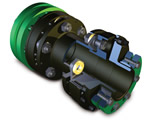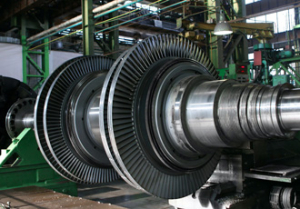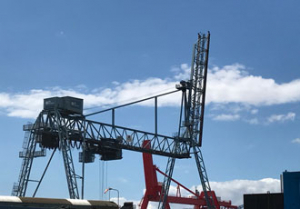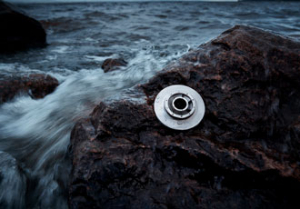Disc Couplings 101 – Making the World go round
13th December 2012
Source:
Bibby Transmissions Group

As with most of the components that keep high power industrial transmissions running smoothly and efficiently, most of us probably don’t notice the spinning cylinder mounted between the torque supply and the driven device. While high quality couplings can be left to operate problem free for decades, knowledge of how a disc coupling works and how designs differ is invaluable to ensure that when it comes time to specify a new component, the right equipment is selected; after all, a disc coupling’s job is to protect the expensive connected equipment.
Disc couplings are used with many general and specialised industrial applications where the efficient transmission of torque is required; they are able to accommodate misalignment and compensate for end movement between driving and driven equipment. Disc couplings can transmit torque with over 99% efficiency, maintenance free, even in rough or reversing applications. Different applications dictate the requirement for different couplings; however there are two main styles of design.
The two basic styles are the Traditional and Drop-In coupling; the two designs differ in their approach to absorbing the flex that is produced by torque transfer. Traditional disc couplings have a five piece construction - two hubs, one spacer and two flex discs - which involves a lower initial cost and is the lighter of the two. The Drop-In coupling is only three piece - two hubs and a factory assembled spacer that includes flex elements; this leads to faster installation time and a higher balance class.
As well as transmitting torque with almost complete efficiency, disc couplings excel at compensating for both angular and parallel offset misalignments. Unlike common elastomeric coupling types where a single flexing element accommodates all types of misalignment, within a disc coupling a single disc only accommodates angular misalignment; double-flexing couplings are needed to compensate for parallel misalignment. Free end float rating is also an important consideration when specifying a coupling in relation to its ability to compensate for end movement.
The bolting arrangement for couplings is one of the most important design features, an equal number of holes are bolted to the driver as are bolted to the driven hub. Torque is transmitted in tension through half of the links of the flex discs located between the hubs and the spacers; the remaining links operate in compression and are generally not considered in the ratings. Compressed links tend to buckle under load, so flex discs are commonly pre-stretched at installation to allow the compressed sections to relax to neutral under load as they are compressed.
Straight sided and scalloped flex discs are the two most commonly used blade types (though round discs are still commonly used in many older coupling styles). Straight sided discs are stiffer torsionally so require less pre-stretch and are somewhat easier to assemble. Scalloped discs are ‘stress optimised’ making them lighter and less stiff, though the edge stresses are greater which requires a better edge surface finish; they require costly EDM machining and are typically best suited to custom / high-speed applications.
FEA analysis has shown that material can be removed from the area in the middle of the span between bolt holes without affecting the disc’s ability to handle axial and angular misalignment, so straight sided and scalloped discs perform equally. However, straight sided discs are better suited to fluctuating and reversing loads commonly found in general purpose applications so torque requirements are often a deciding factor in disc style selection.
Applications requiring disc couplings are found through general industry, wherever the transfer of torque from driving to driven equipment is necessary. Typical applications include pumps, compressors, machine tools, engine driving equipment, food processing equipment, blowers & fans and test equipment.
While couplings should be a ‘fit-and-forget’ component, there are still many design details that should be considered at the point of specification to ensure many years of maintenance free running and the protection of other, rotating parts connected to it. High quality manufacturers such as Bibby will provide pre and post sale support for all applications to ensure that the right coupling is selected.
The two basic styles are the Traditional and Drop-In coupling; the two designs differ in their approach to absorbing the flex that is produced by torque transfer. Traditional disc couplings have a five piece construction - two hubs, one spacer and two flex discs - which involves a lower initial cost and is the lighter of the two. The Drop-In coupling is only three piece - two hubs and a factory assembled spacer that includes flex elements; this leads to faster installation time and a higher balance class.
As well as transmitting torque with almost complete efficiency, disc couplings excel at compensating for both angular and parallel offset misalignments. Unlike common elastomeric coupling types where a single flexing element accommodates all types of misalignment, within a disc coupling a single disc only accommodates angular misalignment; double-flexing couplings are needed to compensate for parallel misalignment. Free end float rating is also an important consideration when specifying a coupling in relation to its ability to compensate for end movement.
The bolting arrangement for couplings is one of the most important design features, an equal number of holes are bolted to the driver as are bolted to the driven hub. Torque is transmitted in tension through half of the links of the flex discs located between the hubs and the spacers; the remaining links operate in compression and are generally not considered in the ratings. Compressed links tend to buckle under load, so flex discs are commonly pre-stretched at installation to allow the compressed sections to relax to neutral under load as they are compressed.
Straight sided and scalloped flex discs are the two most commonly used blade types (though round discs are still commonly used in many older coupling styles). Straight sided discs are stiffer torsionally so require less pre-stretch and are somewhat easier to assemble. Scalloped discs are ‘stress optimised’ making them lighter and less stiff, though the edge stresses are greater which requires a better edge surface finish; they require costly EDM machining and are typically best suited to custom / high-speed applications.
FEA analysis has shown that material can be removed from the area in the middle of the span between bolt holes without affecting the disc’s ability to handle axial and angular misalignment, so straight sided and scalloped discs perform equally. However, straight sided discs are better suited to fluctuating and reversing loads commonly found in general purpose applications so torque requirements are often a deciding factor in disc style selection.
Applications requiring disc couplings are found through general industry, wherever the transfer of torque from driving to driven equipment is necessary. Typical applications include pumps, compressors, machine tools, engine driving equipment, food processing equipment, blowers & fans and test equipment.
While couplings should be a ‘fit-and-forget’ component, there are still many design details that should be considered at the point of specification to ensure many years of maintenance free running and the protection of other, rotating parts connected to it. High quality manufacturers such as Bibby will provide pre and post sale support for all applications to ensure that the right coupling is selected.
Similar articles
More from Bibby Transmissions Group
- New additions to Torsiflex Disc Couplings range enables coupling sizes to be minimised 21st May 2013
- Disc Couplings 101 – Making the World go round 13th December 2012
- Bibby Makes Case Why Manufacturer Repair Of High Performance Couplings Is Best 30th November 2010
- Bibby’s UEP Modular Torque Limiter Provides Maximum Protection Against Overloads On Twin Screw Extruders & Mixers 7th October 2010
Product Centre Updates
2024 World Battery & Energy Storage Industry Expo (WBE)
8th August 2024
China 1st and 2nd Floor, Area A, China Import and Export Fair Complex

-(1)ed.jpg)










Write a comment
No comments